Related Research Articles

The Swedish History Museum is a museum located in Stockholm, Sweden, that covers Swedish archaeology and cultural history from the Mesolithic period to present day. Founded in 1866, it operates as a government agency and is tasked with preserving Swedish historical items as well as making knowledge about history available to the public.
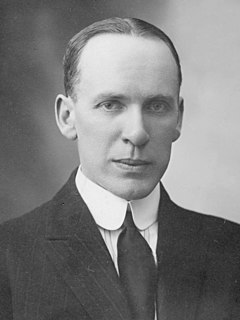
Birger Nerman was a Swedish archaeologist, historian and philologist who specialized in the history and culture of Iron Age Sweden.

Martin Rundkvist is a Swedish archaeologist and associate professor at the University of Łódź in Poland. His research focuses on the Bronze, Iron, and Middle Ages of Scandinavia, and includes significant excavations in the province of Östergötland.
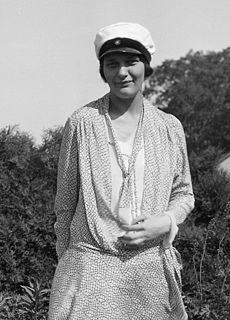
Anna Berit Wallenberg was a Swedish archaeologist, anthropologist, art historian, photographer, and philanthropist. She established a research foundation, the Berit Wallenberg Foundation, that awards funds to these areas. Since its establishment, it has been providing support to cultural heritage institutions, art historians, and archaeologists. In 1936, she became the first Swedish woman to be appointed as a supervisor for the national heritage committee, responsible for the restoration of the Lovö church.
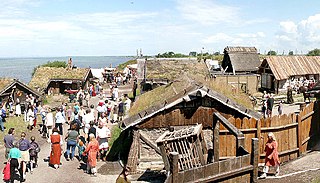
The Foteviken Museum is an archaeological open-air museum on the Höllviken peninsula in southern Skåne, Sweden. It contains a reconstruction of a large Viking Age settlement and a "viking reservation", and visitors participate in living history reenactments; it also performs research and functions as the municipal museum of Vellinge Municipality and part of Fotevikens Kulturcenter, a group of cultural facilities on the peninsula.
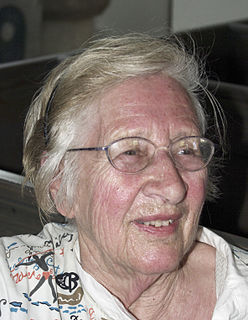
Märta Strömberg was a Swedish archaeologist.
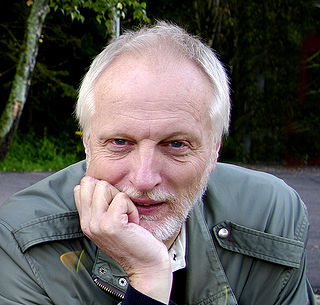
Sven Gunnar Rosborn is a Swedish archaeologist, historian and writer best known for his contributions to the archaeology of the Viking Age in the province of Scania and for his leadership of archaeology and history research and education foundations. He is recognized for the discovery of the Curmsun Disc, a memorial plaque of the great Viking king Harald Bluetooth. The ongoing research by Rosborn may soon lead to the discovery of the original location of the legendary Viking stronghold of Jomsborg.
Inger Zachrisson is a Swedish archaeologist specializing in the history of the Sami people. As Associate Professor of Archaeology at Uppsala University and former curator of Stockholm's History Museum, she has researched Sami archaeology and history since the Iron Age.

Greta Arwidsson was a Swedish archaeologist. Alongside other work, she is known for her study of the Valsgärde graves, published from the 1940s until the 1970s.
Wilhelm Egon Holmqvist was a Swedish archaeologist, art historian and scholar. He published extensively, and among other work led excavations at Helgö.
Vinoš Sofka was a museologist. He co-founded the International Committee for Museology (ICOFOM) in 1977 and served as its chairman and vice chair.
Björn Ambrosiani is a Swedish archaeologist and former civil servant. He worked at the Swedish History Museum and the Swedish National Heritage Board, as a research director among other positions.
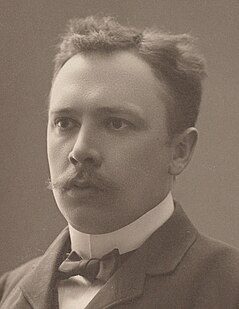
Knut Martin Stjerna was a Swedish archaeologist and scholar, notable for a number of papers analyzing Beowulf from an archaeological perspective. He was a lecturer at Uppsala University, where he taught, among others, Birger Nerman and Sune Lindqvist.
Dominic Tweddle,, is an English archaeologist specialising in Anglo-Saxon studies and the Director General of the National Museum of the Royal Navy. Previously he spent time as a Research Assistant at the British Museum and as the Assistant Director of the York Archaeological Trust, where he helped develop the Jorvik Viking Centre. He is also an honorary professor at the UCL Institute of Archaeology and the University of Portsmouth.

Birgit Arrhenius is a Swedish archaeologist and professor emeritus at Stockholm University. She was a professor of laboratory archaeology, and the first head of the university's Archaeological Research Laboratory. Her work has studied places including Helgö and Mälaren, and she has researched prehistoric pressblech and garnet cloisonné work. Arrhenius is a member of the Royal Swedish Academy of Sciences, and was in 1992 the recipient of the Royal Patriotic Society's Gösta Berg Medal.
Sanne Houby-Nielsen is a Danish-Swedish archaeologist and museum director. After spending five years as director of the Swedish National Museums of World Culture in Gothenburg, since February 2015 she has headed Sweden's Nordic Museum in Stockholm.

Asta Ekenvall was a Swedish librarian, one of the founders of the Kvinnohistorisk arkiv of the University of Gothenburg and a pioneer in research and philosophy of women's history.
Therése Sjömander Magnusson, is a Swedish water researcher and head of the Nordic Africa Institute.

Carl L. Thunberg, FSAScot is a Swedish historian and archaeologist, with a profile of renewed, extensive studies of classic source materials. As a scholar, Thunberg has worked in several fields in his academic disciplines, but is perhaps best known for his in-depth specialized works on source material regarding the period from the Viking Age to the Nordic Middle Ages. He has also been active in the field of popular history. In addition to his writing, he is known for his commitment to the Swedish cultural heritage, in terms of antiquities and ancient sites, and for his public lectures.
Lili Sanelma Nyström was a Swedish archaeologist and museum director. She was the wife of Swedish historian and the former governor of Gothenburg and Bohus County, Per Nyström. She was the founder of the Lili Kaelas stiftelse för arkeologisk forskning.
References
- ↑ "Katherine Hauptman ny chef för Historiska museet" (in Swedish). Historiska. 3 April 2018. Retrieved 3 April 2018.
- 1 2 "Katherine Hauptman" (in Swedish). Nordic Academic Press. Retrieved 3 April 2018.
- ↑ "Katherine Hauptman blir chef för det nya Förintelsemuseet". DN.SE (in Swedish). 2022-01-20. Retrieved 2022-01-23.
- ↑ "Genusförbart" (in Swedish). Nordic Academic Press. Retrieved 4 April 2018.
- ↑ "Svenska ICOMs styrelse" (in Swedish). ICOM Sweden. Retrieved 4 April 2018.
- ↑ "Museer är vårt gemensamma minne – intervju med Katherine Hauptman" (in Swedish). UNESCO Sweden. 23 February 2017. Retrieved 4 April 2018.